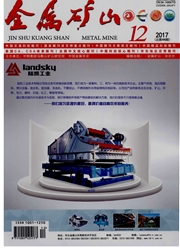

 中文摘要:
中文摘要:
綦江铁矿石主要有用元素铁含量为35.47%,铁主要以赤铁矿和菱铁矿的形式存在,铁在赤铁矿和菱铁矿中分布率分别为45.45%和51.11%。对磨至不同粒度矿石进行悬浮焙烧—弱磁选试验结果表明,磨矿细度为-0.074 mm占50%时,精矿指标最佳。对磨至-0.074 mm占50%的产品筛析为+0.1、0.074-0.1、0.045-0.074、-0.045 mm 4个粒级,分别进行悬浮焙烧—弱磁选试验。结果表明:给料粒度为0.074-0.1 mm和0.045-0.074 mm时,获得的精矿指标相对较佳。对不同给料粒度焙烧产品的XRD和磁性分析结果表明:+0.1 mm粒级因颗粒粒度较大,反应不完全,仍有部分赤铁矿和菱铁矿因未被还原而存在于还原物料中;0.074-0.1 mm和0.045-0.074 mm粒级焙烧产品中铁矿物主要为磁性较强的磁铁矿;-0.045 mm粒级焙烧产品产生过还原现象,生成了弱磁性的浮氏体。试验结果可以为綦江铁矿石悬浮焙烧工艺优化提供依据。
 英文摘要:
英文摘要:
Main valuable element of iron ore from Qijiang is iron,with grade of 35. 47%. Iron mainly exists in form of hematite and siderite,with distribution of 45. 45% and 51. 11% respectively. The results of suspension roasting-low intensity magnetic separation experiment on ground products with different size show that,concentrate index is optimum when grinding fineness is-0. 074 mm accounted for 50%. Suspension roasting-low intensity magnetic separation experiment was conducted on products with size of-0. 074 mm accounted for 50% sieve to +0. 1,0. 074 - 0. 1,0. 045 - 0. 074,-0. 045 mm. Results indicate the concentrate index was relatively good when the feed particle size was 0. 045 - 0. 074 mm and 0. 074 - 0. 1 mm. The XRD and magnetism analysis on products with different particle size show that the reaction is not complete and there are still some hematite and siderite have not been reduced in reduced products for +0. 1 mm fraction for too large particle size; iron minerals of reduced products for 0. 074 - 0. 1 mm and 0. 045 - 0. 074 mm fraction is mainly high intensity magnetic magnetite;over reduction performance was took place in-0. 045 mm fraction,and low intensity magnetic wustite was generated. The results can provide technique basis for the optimization of the suspension roasting process of Qijiang iron ore.
 同期刊论文项目
同期刊论文项目
 同项目期刊论文
同项目期刊论文
 期刊信息
期刊信息
